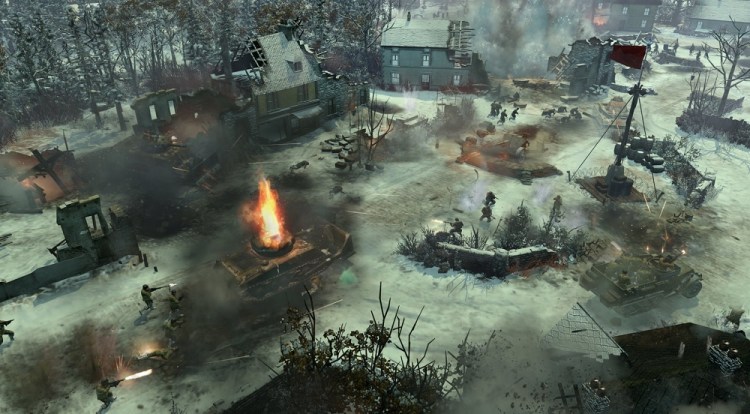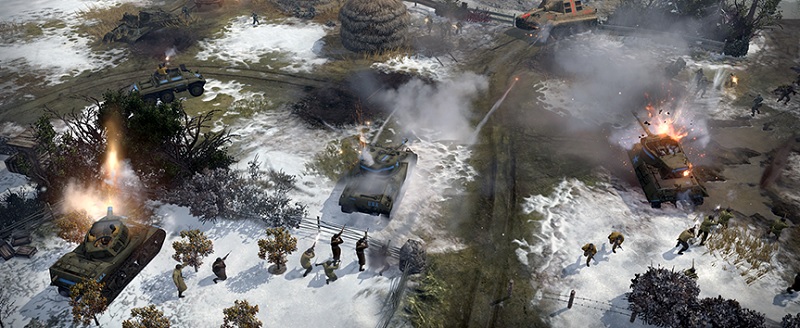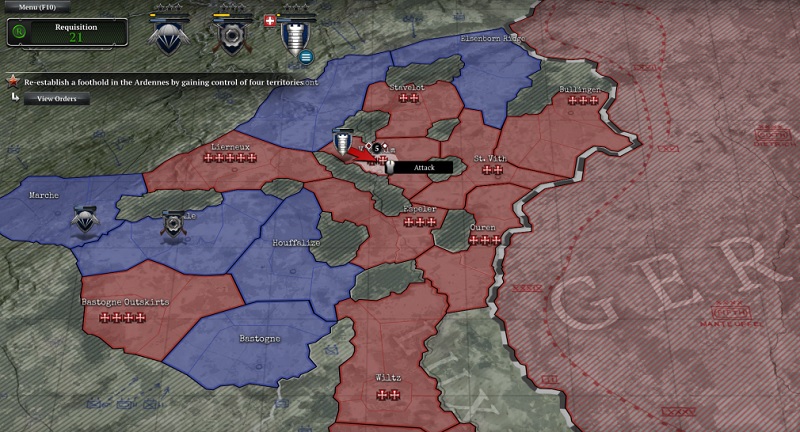Beautiful and destructible terrain
The beautifully rendered towns and snow-covered trees offer lots of cover for infantry, and they make it hard for the tanks to maneuver without being ambushed by anti-tank infantry. When soldiers and tanks move through the snow, they leave tracks.
The artwork faithfully reproduces villages and forests in the Ardennes, so that you can fight battles on the key terrain like bridges or church towers. That terrain is also quite destructible. If a tank comes across an infantry squad in a church, it will waste no time reducing it to rubble.
All of the maps are very different from each other. And you can layer effects on top of the terrain. For instance, a battle may take place at night, or in day time. Or you can toss smoke grenades to obscure the views. A burning tank may provide some cover from machine gun fire.
That all adds to the feeling that you’re really in the Ardennes.
Dynamic gameplay where heroes matter
The campaign is non-linear, as you can choose to fight in any section of the strategic meta-map that shows the various locations that you must control. If you cut off the German supply line, you can cause a lot of havoc. When you lower the boom by attacking an encircled German force, it will be destroyed because it has nowhere to retreat.
Within each map, the game play is also dynamic. You could repeatedly play a mission like Stavelot, where you have to stop the enemy from sending fuel trucks off the map. Each time you start the mission, the location of the fuel dump and the exit location is different.
Your experience will be different depending on which company you use to attack. A support company will call upon a lot of off-screen artillery. An airborne company will have crack paratroopers who can land behind enemy lines. And the mechanized company can draw upon tanks.
Quite often, the battle came down to skirmishes between a few surviving squads. If one squad has veteran status and is well armed, it can take out numerous German tanks or squads. Sometimes, the whole victory will depend on how one squad performs. And when you replay the mission, you may get a very different result.
A strategic meta game
Your troop companies are persistent from mission to mission. They can take damage, and they can gain veterancy. You can preserve veteran units, or dilute them with replacements. In between missions, you can spend the points you earn on more combat resources, such as grenade-equipped squads, air power, or off-map artillery strikes.
These decisions matter because your goal is to cut off the Germans and eliminate them. If you make the wrong decisions, your companies will be under-strength, and they won’t be able to take out the final remaining German force. You only have three companies, and if you lose all three of them, you’ll go down in defeat.
Upgrades really matter
Sometimes, you have lots of choices for upgrades in games, but they don’t really accomplish anything. That’s not the case here. With each completed mission, you get a number of points to spend on your unit. Sometimes, you have to just reinforce the unit after getting badly mauled. This hurts the veterancy status of the company, but you have to do it. If you unit survives unscathed, then you’ll be able to spend your points on things that make a difference.
You can, for instance, speed up the time it takes to land paratrooper reinforcements. If you spend more points, you can get two squads to land and a fighter to strafe the ground ahead of your landing. If you spend still more, you can get a heavy machine gun to drop with the paratroopers. These upgrades can be critical to re-arming your troops in a heated battle.
As the battles become more difficult later in the campaign, you really need these upgraded abilities to survive.
An appreciation for history
The folks at Relic always do their homework. They get the hardcore history right, for the most part. You can appreciate just how terrifying the Tiger II tanks were on the battlefield, as they rumbled through towns crushing buildings. If you’re trying to take it out with a bazooka, good luck. (At least it’s vulnerable in the rear armor). All of that historical data is rock solid.
But it’s not a cold-blooded war game. It’s a simulation that reproduces what it was like, and it stirs a lot of emotion as you hear the screams of dying soldiers or see the full consequences of a bloody brawl within the larger campaign. This is more like a living history, where you feel more like you’ve been transported to another time.




